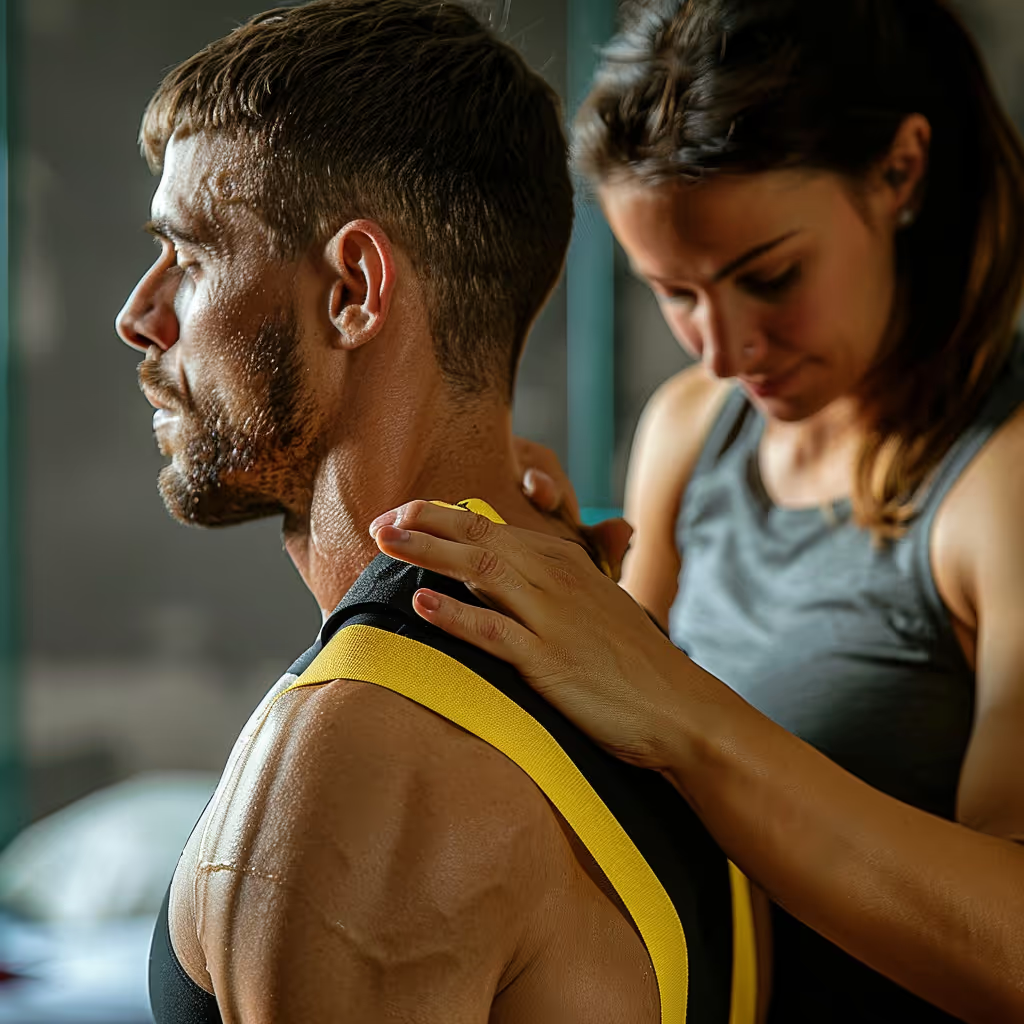Ankylosing Spondylitis
This is a chronic inflammatory disease of the spine.
What is ankylosing spondylitis?
This is a chronic inflammatory disease of the spine.
Who is most at risk of developing ankylosing spondylitis?
- The disease usually appears in one's thirties.
- The onset of the disease is almost always before the age of 40.
- Men are two to three times more affected by this disease than women.
- The chance of having this disease is about 1 to 2% in the general population.
What are the symptoms of ankylosing spondylitis?
It is important to understand that ankylosing spondylitis does not always cause symptoms. Symptoms may also appear in episodes throughout life.
Common symptoms include:
- Lower back pain present for at least three months
- The pain improves with exercise and is worse with rest.
- The pain is often present at night and in the morning for the first 30 minutes and improves during the day with movement.
- Stiffness of the spine, which leads to the development of hyperkyphosis of the spine (very rounded back).
- Often there is pain in one or both buttocks.
Some people may also experience other symptoms such as:
- Pain in several other joints at the same time for no apparent reason.
- Excessive fatigue
What are the serious symptoms of ankylosing spondylitis to watch out for?
The presence of certain signs and symptoms should prompt you to seek immediate medical attention at the emergency room or from a doctor. These include:
- Severe weakness or paralysis of one or both legs
- Significant or even complete loss of sensation in one or both legs
- Recent loss of balance when walking
- Significant and new incoordination
- New difficulties with bladder or bowel control
- Loss of sensation in the genital area or when wiping after a bowel movement
Serious symptoms are only present in less than 1% of cases of lower back pain. Most of the time, although the pain can be very unpleasant, the condition improves.
What are the causes of ankylosing spondylitis?
The exact cause of the disease is unknown. There appears to be a genetic influence.
How is ankylosing spondylitis diagnosed?
The diagnosis can be made based on a history of symptoms, a clinical examination, certain medical imaging tests, and blood tests.
It's important to know that medical imaging (X-rays, MRIs, etc.) isn't relevant in 99% of back pain cases.
When should you see a physiotherapist for ankylosing spondylitis?
You should consult a physiotherapist if you have symptoms as described above or if your doctor has already ruled out any other cause that may be responsible for your pain.
You do not need to see a doctor before consulting a physiotherapist. If your condition requires you to see a doctor, your physiotherapist will be able to tell you.
What physiotherapy treatments are available for ankylosing spondylitis?
Your physiotherapist will perform an assessment to determine your limitations by evaluating the following elements:
- The mobility of your spine
- The gliding of your nerves
- Your postural habits
- The quality of your movements
- Your strength and stability
Based on the assessment results, your physiotherapist will:
- Will mobilize the joints in your back and your nerves to reduce pain and improve movement.
- Will give you specific exercises to do at home to address the cause of the problem and reduce pain.
- Teach you how to properly manage your daily activities and hobbies to optimize healing
- Will give you advice for your postural habits and movements.
It's important to note that ankylosing spondylitis cannot be cured, as it is a lifelong condition. However, the symptoms associated with the disease can be effectively managed or even eliminated with treatment, even if the disease is still present.
What can you do at home for ankylosing spondylitis?
Avoid staying completely still for long periods, as this will cause increased stiffness and pain afterwards.
The best thing to do is to stay active. If you're sedentary, start by taking regular walks and doing mobility exercises for your back, while respecting your pain levels each day. If you're already active, continue with activities that don't cause too much pain.
If you do not see any improvement, you should consult a physiotherapist.
To learn more...
You can listen to the podcast "Parle-moi de santé" produced by one of our physiotherapists, Alexis Gougeon. Episode #7 discusses the topic of lower back pain.
Episode #7 lower back pain
Find the episode on YouTube :
Click below to listen to episodes on podcast platforms:

https://open.spotify.com/episode/3Ymcb0gWLyns48Kb6vJ5J8?si=092c6516549b47d7
(4).png)
Sources
- Wenker KJ, Quint JM. Ankylosing spondylitis.
- Zhu W, He X, Cheng K, Zhang L, Chen D, Wang X, Qiu G, Cao X, Weng X. Ankylosing spondylitis: etiology, pathogenesis, and treatments. Bone Research. 2019 Aug 5;7(1):1-6.
- Sieper J, Braun J, Rudwaleit M, Boonen A, Zink A. Ankylosing spondylitis: an overview. Annals of the rheumatic diseases. 2002 Nov 1;61(suppl 3):iii8-18.
- McVeigh CM, Cairns AP. Diagnosis and management of ankylosing spondylitis. Bmj. 2006 Sep 14;333(7568):581-5.
Videos in this category
Other conditions
Hip osteoarthritis is a normal wear and tear of the hip joint. Osteoarthritis is often described as the wearing away of cartilage between our bones. While this is true, it involves more than just cartilage. Cartilage is a tissue that acts like a cushion between the surfaces of our bones, allowing our joints to glide smoothly and move with ease.
It is a normal wear and tear of the knee joint. Osteoarthritis is often described as the wearing away of cartilage between our bones. While this is true, it involves more than just cartilage. Cartilage is a tissue that acts like a cushion between the surfaces of our bones, allowing our joints to glide smoothly and move with ease.
It is a normal wear and tear of the joints in the lower back vertebrae. Osteoarthritis is often described as the wearing away of cartilage between our vertebrae. While this is true, it involves more than just cartilage. Cartilage is a tissue that acts like a cushion between the surfaces of our vertebrae, allowing them to glide smoothly and move with ease.
A bursa is like a small, very thin, fluid-filled sac found in several joints throughout the body. This small sac acts as a cushion in the joint and lubricates structures that are exposed to more friction.
It is an inflammation of the subacromial bursa in the shoulder joint.
It is a tissue that surrounds the shoulder and allows the shoulder bone to stay in place within the joint. The capsule helps to stabilize the joint.
Cervicalgia is a general term to describe neck pain that does not have a specific cause, such as an accident or sudden movement. Cervicalgia is therefore synonymous with ''I have a pain in my neck and nothing in particular happened''.
In both injuries, there is pain felt in the neck that then radiates into the arm, or vice versa.
It is a significant stretch or tear of the muscle fibers in the groin or inner thigh muscles.
It is a significant stretch or tear of the muscle fibers in the hamstring muscles located at the back of the thigh.
This is a significant stretch or tear of the muscle fibers in the calf muscles (soleus and gastrocnemius).
This is a significant stretch or tear of the muscle fibers in the quadriceps, which is the large muscle at the front of the thigh.
Book an appointment now
We offer a triple quality guarantee: optimized time, double physiotherapy assessment, and ongoing expertise for effective care tailored to your needs.


Our clients' satisfaction is our priority.
At Physioactif, excellence defines our approach. But don't take our word for it, see what our patients are saying.
Discover our physiotherapy clinics
We have multiple locations to better serve you.
Blainville
190 Chem. du Bas-de-Sainte-Thérèse Bureau 110,
Blainville, Quebec
J7B 1A7
Laval
Montreal
St-Eustache
Vaudreuil
21 Cité-des-Jeunes Blvd. Suite 240,
Vaudreuil-Dorion, Quebec
J7V 0N3
Book an appointment now

